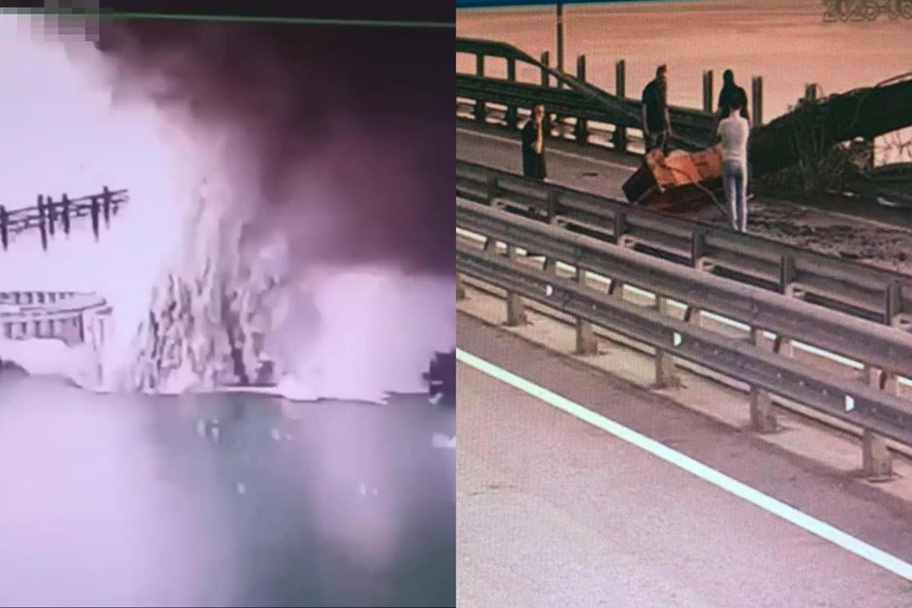In a dramatic escalation of its ongoing conflict with Russia, Ukraine launched a targeted underwater explosive attack on the Kerch Strait Bridge, also known as the Crimea Bridge, early Tuesday morning. The strike, reportedly carried out using unmanned underwater drones or marine charges, dealt a severe blow to one of Russia’s most critical infrastructure links between mainland Russia and the occupied Crimean Peninsula.
The attack has not only disrupted military logistics but also sent a powerful symbolic message, reiterating Ukraine’s capability and intent to reclaim Crimea—annexed by Russia in 2014.
The Bridge and Its Strategic Importance
Spanning 19 kilometers across the Kerch Strait, the Crimea Bridge serves as a crucial artery for transporting troops, weapons, and supplies to Russian forces operating in southern Ukraine. Built at a cost of over $3.7 billion and inaugurated by Russian President Vladimir Putin in 2018, the bridge has become both a logistical lifeline and a nationalistic symbol of Russia’s annexation of Crimea.
The bridge comprises a rail and a road section, both of which have been targeted in previous attacks, including an infamous truck bombing in October 2022 that temporarily halted traffic. This latest strike, however, marks a new method of attack—using sub-surface explosives.
Details of the Attack
Ukrainian intelligence sources, speaking anonymously to several international outlets, confirmed the use of underwater explosives. The operation was reportedly executed by Ukraine’s Security Service (SBU) and the Special Operations Forces (SSO). Ukrainian officials have not publicly claimed responsibility in explicit terms, following their standard policy of strategic ambiguity, but multiple confirmations from Western and Ukrainian intelligence suggest Kyiv's involvement.
Reports indicate that the explosives were placed beneath one of the supporting pillars of the bridge and detonated remotely, resulting in significant structural damage. A section of the road bridge reportedly collapsed into the sea, and rail traffic has been suspended for inspections. Initial images from Russian state media showed twisted metal and broken concrete, while smoke billowed from the partially destroyed span.
The Russian Ministry of Transport confirmed the disruption and has closed the bridge indefinitely, rerouting both civilian and military traffic via alternate land routes through occupied southern Ukraine.
Military and Political Implications
This calculated strike comes at a critical time in the war. With the conflict now in its third year, Ukraine is increasingly leaning on asymmetric warfare and drone-based strategies to offset Russia’s numerical and technological superiority.
Targeting the Crimea Bridge serves a dual purpose: it hampers the Russian military’s ability to resupply its southern front, particularly in the Zaporizhzhia and Kherson regions, and also sends a potent psychological message to Russian leadership and the public.
“This is not just an act of sabotage—it’s a statement,” said Oleksandr Musiyenko, a Kyiv-based military analyst. “Crimea remains in play. Ukraine will not rest until it is liberated.”
From a strategic standpoint, this attack is expected to force Russia to rethink its logistics across the southern front. With Ukraine already targeting ammunition depots and supply convoys with long-range missiles and drones, the bridge’s partial destruction adds another headache for Moscow.
Russia’s Response
The Kremlin has reacted with fury. President Vladimir Putin called the attack “a terrorist act by the Kyiv regime” and vowed a “severe and proportionate response.” Russian forces have already stepped up missile and drone strikes across Ukraine, targeting infrastructure and energy facilities, particularly in Odesa and Mykolaiv.
Dmitry Medvedev, the former president and current deputy head of Russia’s Security Council, took to Telegram, saying, “We must eliminate the very decision-making centers in Ukraine. They must understand the price for touching Russian territory.”
Moscow's framing of the attack as an assault on Russian soil reflects its longstanding claim over Crimea, despite widespread international rejection of its 2014 annexation.
International Reaction
The global response has been cautious but largely supportive of Ukraine’s right to self-defense. U.S. and EU officials have not condemned the strike, viewing it as a legitimate military target due to the bridge's use in supplying occupying forces.
“Crimea is Ukraine,” said a NATO spokesperson in Brussels. “Any effort to weaken the Russian military occupation is within Ukraine’s sovereign right.”
However, concerns have been raised over potential escalation. With tensions already running high and Russia increasing its threats of retaliation, some diplomats worry that strikes inside Crimea could push Moscow toward more aggressive tactics.
What Comes Next?
The attack on the Crimea Bridge underscores Ukraine’s growing proficiency in unconventional warfare and its determination to strike deep behind Russian lines. The use of underwater explosives, a relatively new tactic in this conflict, showcases Kyiv’s innovative military tactics and ability to surprise even heavily fortified Russian targets.
Analysts believe future strikes on infrastructure in Crimea and occupied territories are likely, especially as Ukraine waits for the arrival of additional Western military aid, including long-range missile systems.
Meanwhile, Russia is expected to ramp up defensive measures around the bridge, including anti-drone nets, underwater sonar systems, and increased patrols. But as this latest operation has shown, no system is foolproof.
Conclusion
Ukraine’s latest strike on the Crimea Bridge is a stark reminder of the war’s evolving nature. It demonstrates that Kyiv, even under constant attack, retains the ability to disrupt, adapt, and strike symbolic and strategic targets far behind enemy lines.
As the war grinds on, the destruction of this vital bridge could become a turning point—not just in logistics, but in morale and geopolitical messaging. Whether it leads to negotiations or a harsher response remains to be seen, but one thing is clear: Crimea is no longer untouchable.
